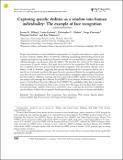| dc.contributor.author | Wilmer, Jeremy B. | |
| dc.contributor.author | Germine, Laura | |
| dc.contributor.author | Chabris, Christopher F. | |
| dc.contributor.author | Chatterjee, Garga | |
| dc.contributor.author | Gerbasi, Margaret | |
| dc.contributor.author | Nakayama, Ken | |
| dc.date.accessioned | 2013-12-06T18:00:04Z | |
| dc.date.available | 2013-12-06T18:00:04Z | |
| dc.date.issued | 2013-02 | |
| dc.identifier.issn | 0264-3294 | |
| dc.identifier.issn | 1464-0627 | |
| dc.identifier.uri | http://hdl.handle.net/1721.1/82668 | |
| dc.description.abstract | Proper characterization of each individual's unique pattern of strengths and weaknesses requires good measures of diverse abilities. Here, we advocate combining our growing understanding of neural and cognitive mechanisms with modern psychometric methods in a renewed effort to capture human individuality through a consideration of specific abilities. We articulate five criteria for the isolation and measurement of specific abilities, then apply these criteria to face recognition. We cleanly dissociate face recognition from more general visual and verbal recognition. This dissociation stretches across ability as well as disability, suggesting that specific developmental face recognition deficits are a special case of a broader specificity that spans the entire spectrum of human face recognition performance. Item-by-item results from 1,471 web-tested participants, included as supplementary information, fuel item analyses, validation, norming, and item response theory (IRT) analyses of our three tests: (a) the widely used Cambridge Face Memory Test (CFMT); (b) an Abstract Art Memory Test (AAMT), and (c) a Verbal Paired-Associates Memory Test (VPMT). The availability of this data set provides a solid foundation for interpreting future scores on these tests. We argue that the allied fields of experimental psychology, cognitive neuroscience, and vision science could fuel the discovery of additional specific abilities to add to face recognition, thereby providing new perspectives on human individuality. | en_US |
| dc.language.iso | en_US | |
| dc.publisher | Taylor & Francis | en_US |
| dc.relation.isversionof | http://dx.doi.org/10.1080/02643294.2012.753433 | en_US |
| dc.rights | Article is made available in accordance with the publisher's policy and may be subject to US copyright law. Please refer to the publisher's site for terms of use. | en_US |
| dc.source | PMC | en_US |
| dc.title | Capturing specific abilities as a window into human individuality: The example of face recognition | en_US |
| dc.type | Article | en_US |
| dc.identifier.citation | Wilmer, Jeremy B., Laura Germine, Christopher F. Chabris, Garga Chatterjee, Margaret Gerbasi, and Ken Nakayama. “Capturing specific abilities as a window into human individuality: The example of face recognition.” Cognitive Neuropsychology 29, no. 5 6 (September 2012): 360-392. © 2012 Psychology Press, an imprint of the Taylor & Francis Group, an Informa business | en_US |
| dc.contributor.department | Massachusetts Institute of Technology. Department of Brain and Cognitive Sciences | en_US |
| dc.contributor.mitauthor | Chatterjee, Garga | en_US |
| dc.relation.journal | Cognitive Neuropsychology | en_US |
| dc.eprint.version | Final published version | en_US |
| dc.type.uri | http://purl.org/eprint/type/JournalArticle | en_US |
| eprint.status | http://purl.org/eprint/status/PeerReviewed | en_US |
| dspace.orderedauthors | Wilmer, Jeremy B.; Germine, Laura; Chabris, Christopher F.; Chatterjee, Garga; Gerbasi, Margaret; Nakayama, Ken | en_US |
| mit.license | PUBLISHER_POLICY | en_US |
| mit.metadata.status | Complete | |
